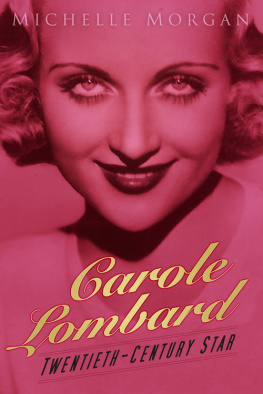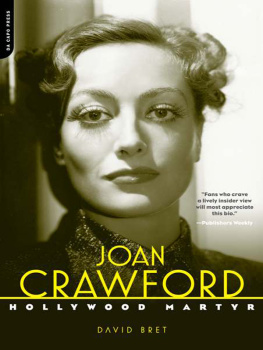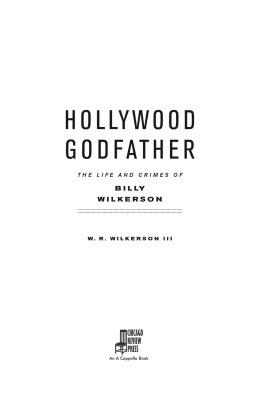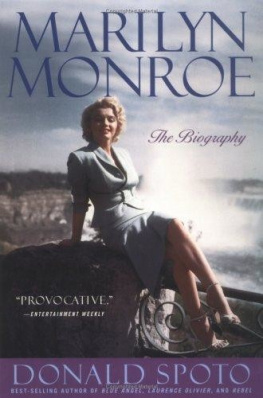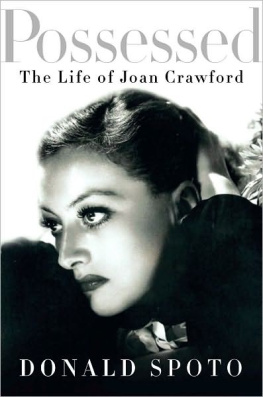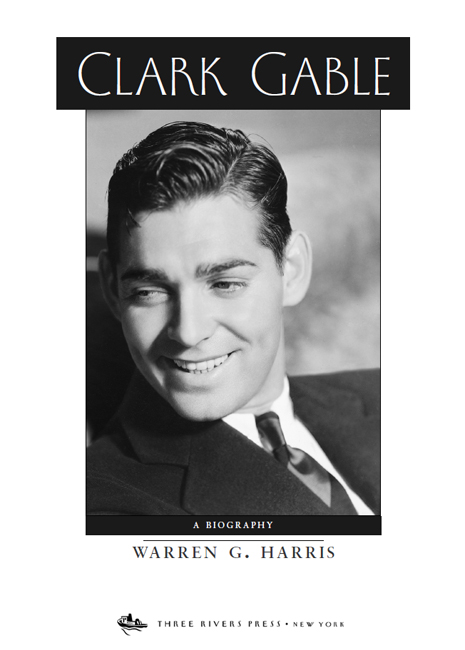FOR KYLE AND JACK,
WHO ARE ALWAYS IN MY HEART
UNCLE WIGGILY
CONTENTS
I
THE KID
C lark Gable should not have been born at all. His mother, Adeline, or Addie as everybody called her, had been sickly for most of her life. Doctors warned her that bearing a child might kill her. It did, but she lingered on and managed to have ten months with her son before she died.
That somber episode began on February 1, 1901, in Cadiz, Ohio, a coal-mining town in that southeastern part of the state that borders on both West Virginia and Pennsylvania. Like most babies in those days, Clark was born at home. The Gables rented the upstairs apartment of a two-family clapboard house on Charleston Street. Instead of the usual midwife, Addies frail health demanded attendance by a doctor. He charged a precious ten dollars and received volunteer help from a woman neighbor from downstairs.
The future King of Hollywood was born just ten days after the death of Queen Victoria and a month after the start of a new century. He was very much a child of the Victorian Era, a time of gaslight, horse-drawn buggies, and prudish conservatism. His mother garbed him in long white dresses and tried to train his abundant brunet hair to part in the middle.
His original name was probably William Clark Gable, but the usual authorities in such mattersincluding birth registrations and school recordscontradict one another. The first name must have been in honor of his father, William Henry Gable, an oil prospector or wildcatter as they were described in those days. Clark was the maiden name of his maternal grandmother. In childhood he was almost always called Clark, though some friends called him Clarkie, Billy, or Gabe. His father confused things even more by always calling him Kid or the Kid when talking about him to others.
Will Gable and Addie Hershelman came originally from Meadville, in northwestern Pennsylvania. Both families were long established in that area and had German ancestry, with a bit of Irish mixed into the Hershelmans. The Gables, however, were Methodists, and the Hershelmans Roman Catholics. The latter were also a tribe of hardworking farmers who didnt approve of Wills religion or of his crazy pursuit of oil gushers. The newlyweds moved 120 miles away to Cadiz to escape the Hershelmans opposition.
Will Gables idol and role model was John D. Rockefeller, who started his Standard Oil empire in Ohio in 1870 and resided near Cleveland on a huge estate called Forrest Hill. Though Rockefeller and rivals had most of Ohio staked out by 1900, small speculators like Will Gable never gave up hope of discovering a payhole that could make them rich too. His sights were set on the booming oil fields around Scio, a village about twenty miles from Cadiz. Daily commuting was impractical, so for most of the week he lived in a tent with other workers. He headed home on Saturday afternoon and returned to the job very early on Monday morning. Such was the routine for many working people well into the new century.
Cadiz, as the seat of Harrison County and a thriving business center, satisfied Addies need to be near doctors and emergency assistance. Records of her health problems are few and contradictory. She may have had epilepsy or some other disease of the central nervous system. Dr. Frank Campbell, who delivered her baby and continued to take care of them both, concluded from her symptoms that she had a progressive brain tumor. She suffered convulsions, and her behavior became increasingly psychotic. Campbell treated her with cabinet steam baths, which were a popular cure-all in those days.
Whatever her illness may have been, it grew worse after the babys birth. How that affected the sexual side of the Gable marriage can only be guessed at, but they were an odd-matched couple to begin with. Will Gable was tall and good-looking, with a reputation as a womanizer and a boozer. Addie was a plain, thickset country girl. Nearly thirty when she married, it may have been the first proposal she ever received.
The Gable baby weighed ten and a half pounds at birth and showed every sign of becoming a big bruiser like his father. His hands and feet were whoppers, and his ears stood out like cup handles. His large gray-green eyes and thick brows were obvious gifts from his mother. His father boasted that he was a born blacksmith.
When the infant turned six months old, Addie persuaded a neighbor to take them to the nearest Catholic church for a christening. Since there wasnt one in Cadiz, they had to travel by horse and buggy to Dennison, twenty-five miles away. The priest berated Addie for delaying the ceremony so long, but that reproach was nothing compared to the tongue-lashing she received from her Methodist husband when he found out. Some of his anger may have been caused by the church certificate, which identified the anointed as Clark Gable rather than William Clark Gable.
In September came shocking news of President William McKinleys assassination, which placed Rough Rider Theodore Roosevelt in the White House. By that time Addie was so ill that Will had taken her and William Clark to the Hershelman farm in Meadville so that her family could take over nursing them. Addie died there on November 14, exactly 286 days after her sons birth.
According to one of the relatives who took care of her, Addie had become all but unmanageable: In a fury, she once hurled Clarks bottle through a window. She went crazy, and then she died.
Only thirty-one years old, Addie Gable was buried in St. Peters Catholic Cemetery near Meadville. The official death certificate cited a six-month case of epilepsy as the cause, even though epilepsy is not a killer disease. Crazy though such a diagnosis may seem, it is all we have to go by. Epilepsy is also not inherited, so whatever effect Addies death had on her son was psychological rather than physical.
Many claims have been made that Clark Gable spent the rest of his life looking for a substitute mother. Whether his mind at the age of nine months was developed enough to be able to grieve or even to notice the disappearance of his mother is debatable, especially since a doting grandmother and an aunt were the dominant caretakers during Addies final phase.
Will Gable left his son with the Hershelmans when he returned to Ohio after the funeral. No way could he take charge of the infant until he had made new living arrangements. Due to his fondness for the ladies, it seemed inevitable that he would marry again, but he apparently had no one specifically in mind. It took him well over a year to find her.
In the meantime the Kid was placed in the care of an uncle, Thomas Hershelman, and his wife, Elizabeth, who had no children of their own. Will gave them a hundred dollars as an advance against the babys upkeep.
Clarks temporary guardians fell so in love with him that they wanted to adopt him. He adjusted easily to farm life. As soon as he could walk, he helped feed the chickens and gather eggs. He had a pet rabbit and chased squirrels in the woods. In later life he said that certain smells always made him homesick for the farm: tomato ketchup cooking, gingerbread baking, cocks crowing, crickets chirping.
In April 1903, two months after Clarks second birthday, Will Gable married thirty-three-year-old Jennie Dunlap of Hopedale, Ohio, an oil boomtown about seven miles northeast of Cadiz. They first met when Will rented a room in the Dunlap familys home on Church Street. Jennie ran a millinery shop and made many of the hats herself. Though not a beauty, she had great flair and was always stylishly dressed and coiffed.



